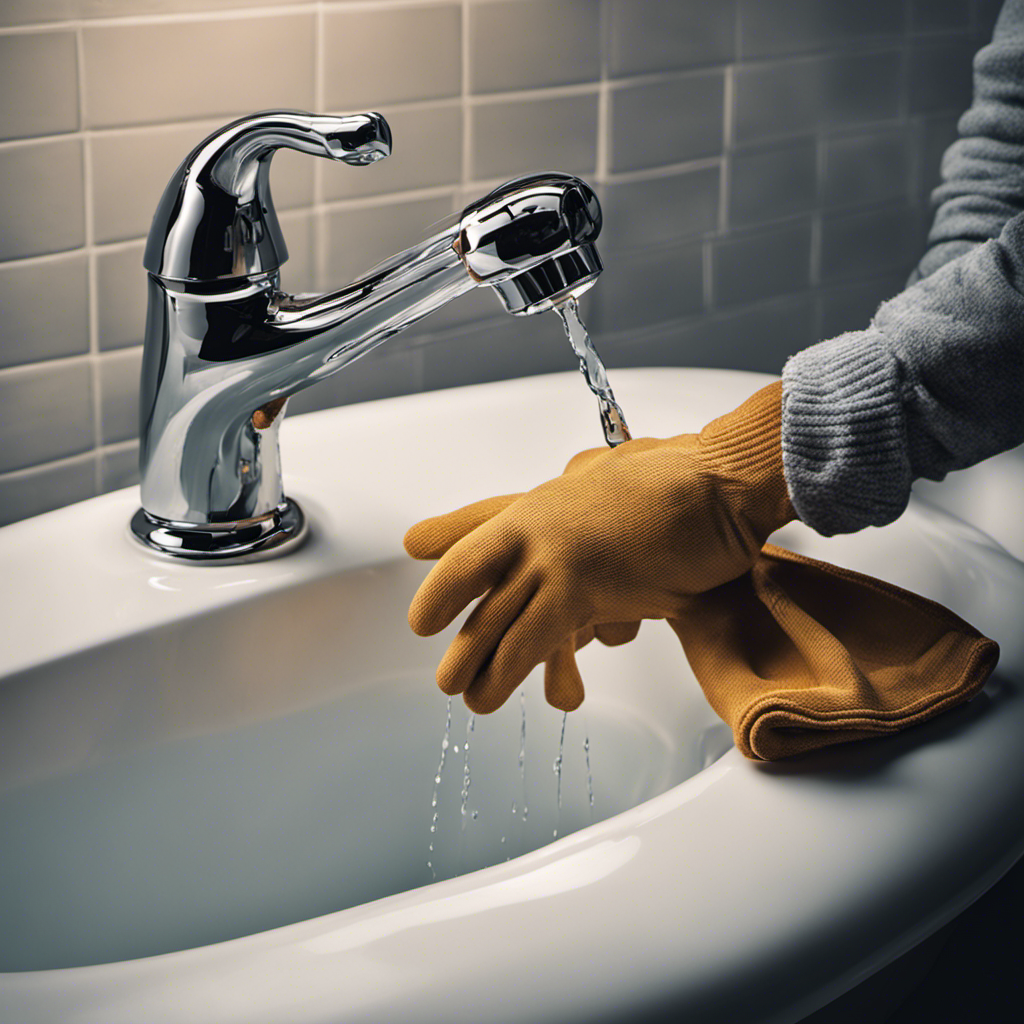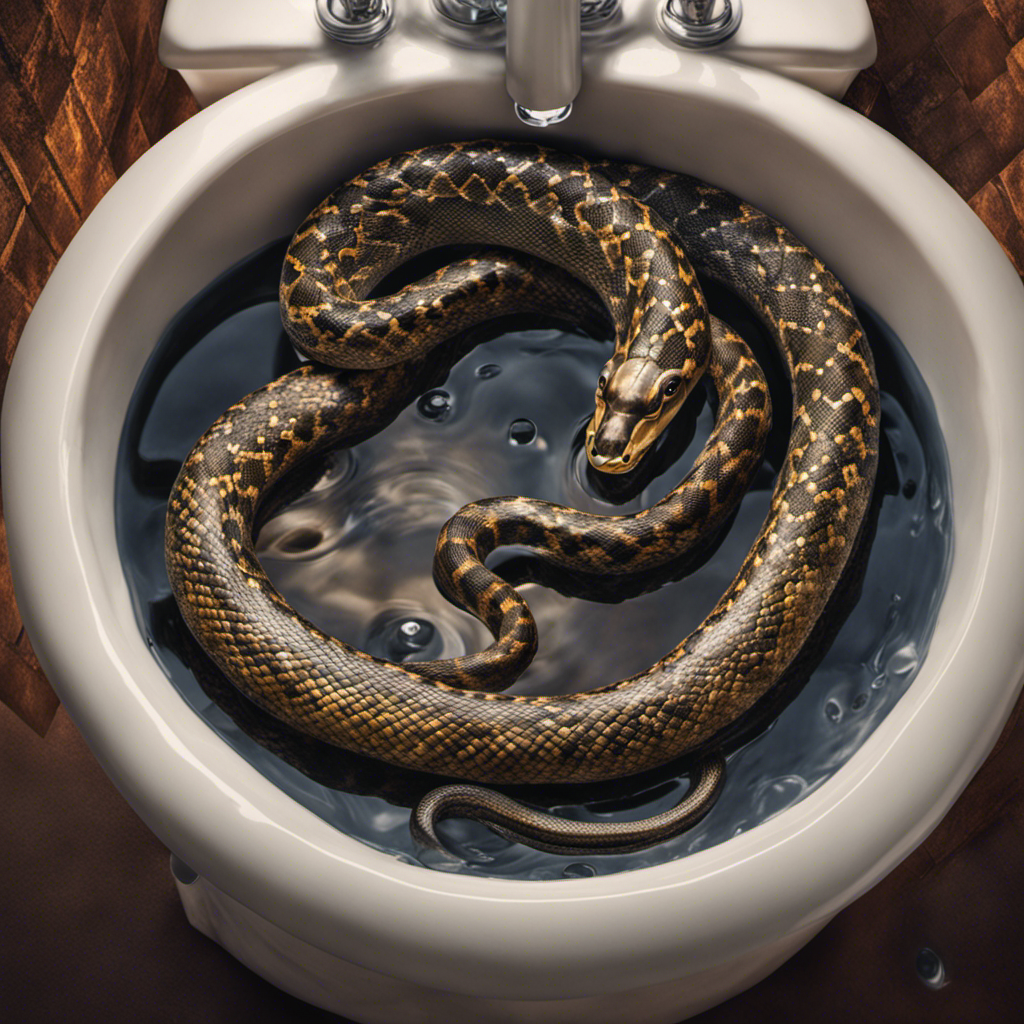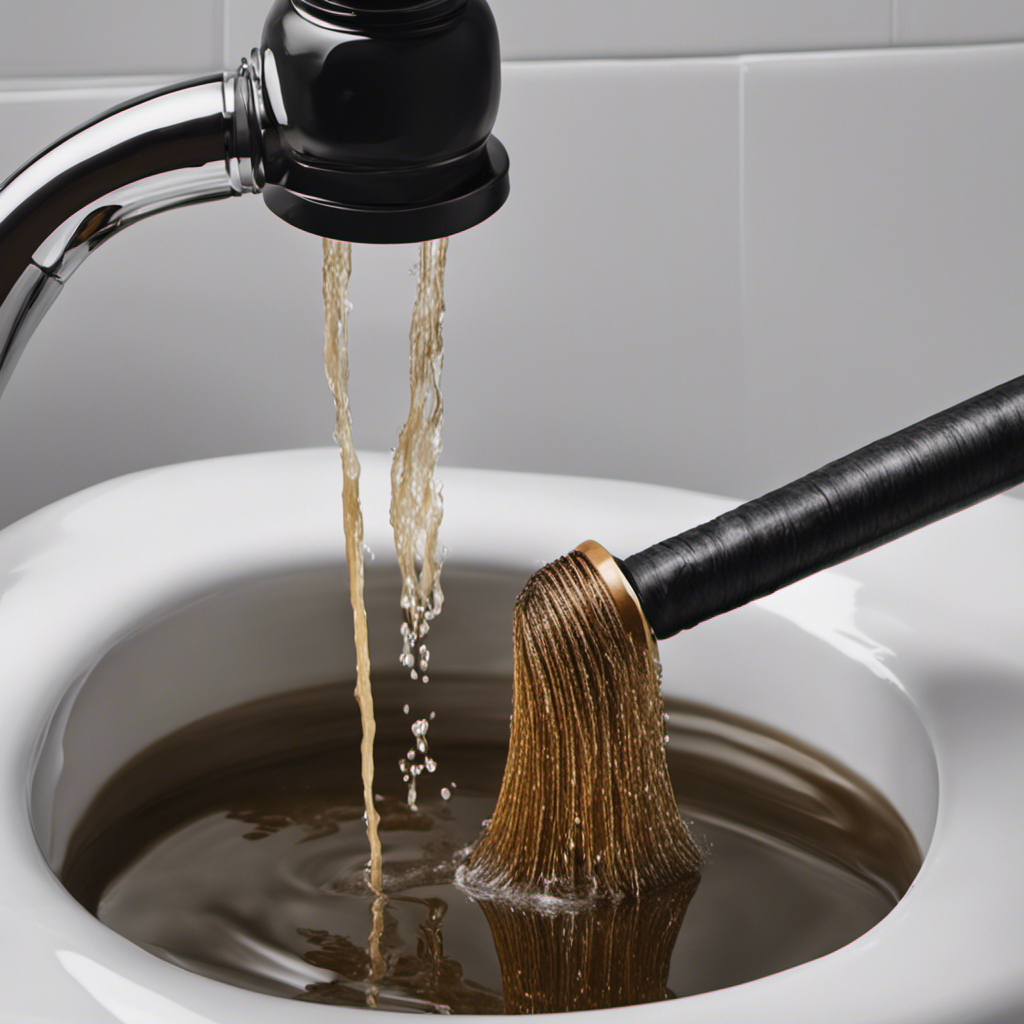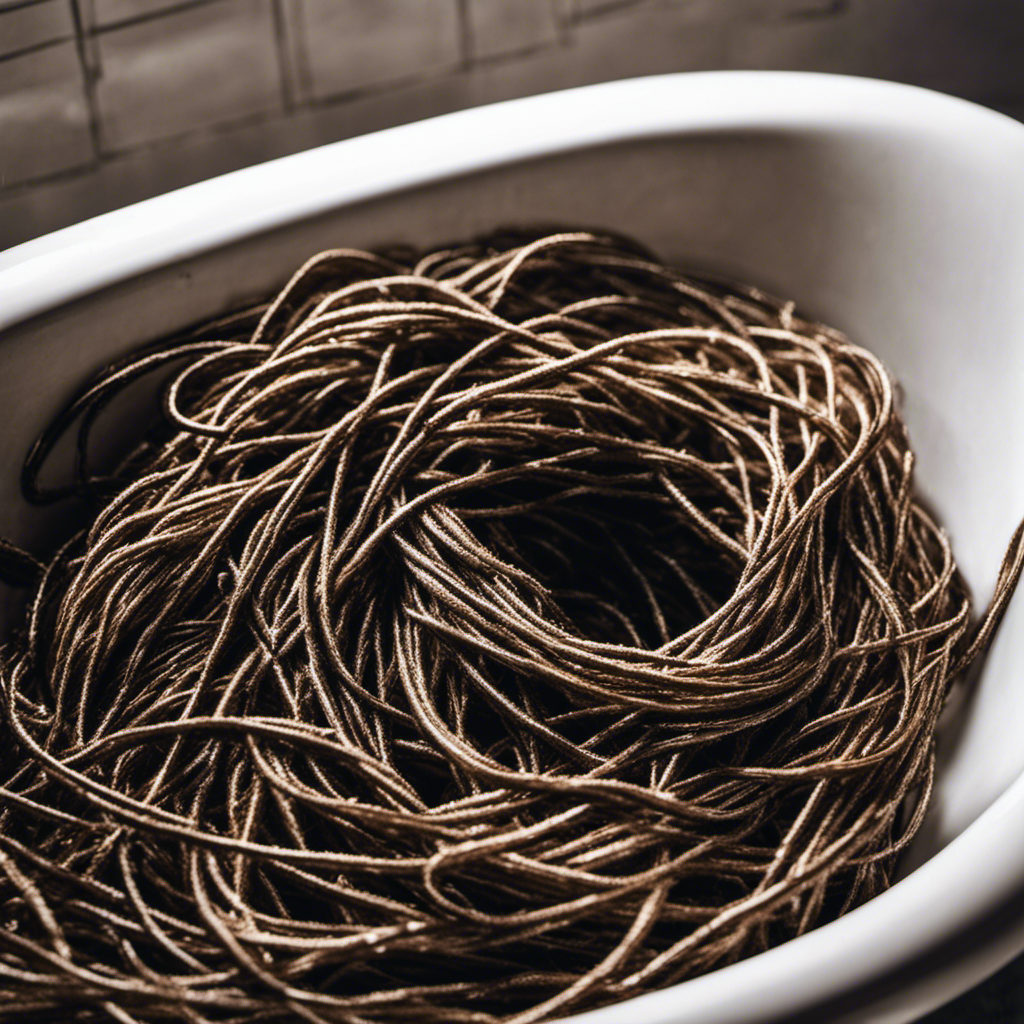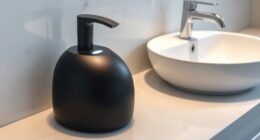Hey there! Ever been in the frustrating situation of having a clogged bathtub drain with standing water? Trust me, I’ve been there too. But don’t worry, I’ve got you covered.
In this article, I’m going to share some effective techniques for unclogging your bathtub drain and getting rid of that pesky standing water. From DIY methods to using chemical products, I’ll walk you through step by step.
So, let’s dive in and get your drain flowing smoothly again!
Key Takeaways
- Hair accumulation, soap scum buildup, and small objects falling into the drain are common causes of clogged bathtub drains.
- Regularly maintaining clean drains by removing hair, soap scum, and debris is important for preventing clogs.
- Using a drain cover or strainer can help catch larger particles and prevent them from going down the drain.
- DIY methods such as using a plunger, drain snake, baking soda and vinegar mixture, or a wire hanger can be effective in unclogging a bathtub drain with standing water.
Causes of a Clogged Bathtub Drain
Do you know what causes your bathtub drain to get clogged?
There are several common household items that can lead to a clogged drain. One of the main culprits is hair. As we shower or bathe, loose strands of hair tend to accumulate and get tangled in the drain.
Another common cause is soap scum and residue. Over time, soap can build up and create a sticky substance that traps other debris and slows down the flow of water.
Additionally, small objects like jewelry or toys accidentally falling into the drain can also cause a blockage.
Fortunately, there are simple ways to unclog a bathtub drain using common household items such as baking soda, vinegar, and a plunger.
Tools Needed for Unclogging a Bathtub Drain
When it comes to unclogging a bathtub drain, having the right tools is essential. In this discussion, I will cover the key points of the essential drain-clearing tools.
Whether it’s better to tackle the job yourself or seek professional help is another important consideration.
Additionally, I will provide cost-effective alternatives to expensive tools.
With this information, you’ll be equipped to handle any clog and get your bathtub drain flowing smoothly again.
Essential Drain-Clearing Tools
To unclog your bathtub drain with standing water, you’ll need some essential drain-clearing tools. Here’s a step-by-step guide, along with cost-effective alternatives, to help you get the job done:
-
Plunger: A plunger is an effective tool for clearing minor clogs. Place it over the drain and use firm, rapid plunges to create suction and dislodge the blockage.
-
Drain Snake: A drain snake, also known as a plumber’s auger, is useful for removing stubborn clogs. Insert the snake into the drain and rotate it to break up the blockage.
-
Baking Soda and Vinegar: For a natural and cost-effective solution, mix equal parts baking soda and vinegar. Pour this mixture down the drain and let it sit for about 30 minutes. Follow it with hot water to flush away the clog.
DIY or Professional Help
If you’re unsure about tackling the clog yourself, consider seeking professional help for your bathtub drain.
While DIY methods can be effective for minor clogs, there are several benefits to hiring a plumber.
First and foremost, plumbers have the experience and expertise to handle even the most stubborn clogs. They have access to specialized tools and techniques that can quickly and effectively clear your drain.
Additionally, hiring a professional ensures that the underlying cause of the clog is properly addressed, preventing future issues. Plumbers can also provide valuable advice on how to maintain your drains and prevent clogs in the future.
Overall, the benefits of hiring a plumber include peace of mind, time savings, and long-term solutions to your drain problems.
Cost-Effective Tool Alternatives
Consider using cost-effective tool alternatives to clear your clogged bathtub. When faced with a clogged drain, it’s important to explore affordable alternatives before resorting to expensive professional help.
Here are three budget-friendly substitutes that can help you unclog your bathtub drain without breaking the bank:
-
Plunger: A plunger is a versatile tool that can be used to unclog various drains, including bathtubs. Simply place the plunger over the drain, create a tight seal, and vigorously plunge up and down to dislodge the clog.
-
Drain snake: Also known as a plumbing auger, a drain snake is a long, flexible wire that can reach deep into your drain to break up and remove clogs. Insert the drain snake into the drain and twist it, allowing the barbs or hooks on the wire to catch onto the clog and pull it out.
-
Baking soda and vinegar: This natural alternative is not only affordable but also environmentally friendly. Pour a cup of baking soda down the drain, followed by a cup of vinegar. Let the mixture fizz for a few minutes, then flush it with hot water. The combination of baking soda and vinegar can help break down and dissolve clogs.
With these cost-effective tool alternatives, you can tackle bathtub clogs without straining your budget.
Preparing the Drain for Unclogging
When it comes to dealing with water removal techniques, having the necessary tools and supplies is crucial. As someone who has faced their fair share of water-related issues, I can confidently say that having the right equipment can make all the difference.
From wet/dry vacuums to sump pumps, these tools are designed to efficiently remove water and minimize any potential damage.
Water Removal Techniques
To remove the standing water from your bathtub, you’ll need to start by using a plunger to attempt to unclog the drain. Here are three water removal techniques that can help you in this process:
-
Plunger Method: Place the plunger over the drain and create a tight seal. Pump the plunger up and down vigorously to create pressure and dislodge the clog. Repeat this process several times until the water starts to drain.
-
Drain Snake: Insert the drain snake into the drain and twist it clockwise or counterclockwise to break up the clog. Pull out the snake carefully, allowing it to catch any debris along the way. Dispose of the debris properly.
-
Wet Vacuum: If you have access to a wet vacuum, use it to extract the water from the bathtub. Attach the hose to the vacuum and position it over the drain. Turn on the vacuum and let it suck out the water.
Necessary Tools and Supplies
You’ll need a plunger, a drain snake, and a wet vacuum to complete the water removal process. These tools are essential for unclogging a bathtub drain with standing water.
However, there are also cost-saving alternatives and eco-friendly options you can consider. For example, instead of using a traditional plunger, you can try using a homemade plunger made from a plastic bottle. Simply cut off the bottom of the bottle and use the top part to create suction. This is a great eco-friendly option that doesn’t require spending money on a new plunger.
Additionally, instead of using harsh chemical drain cleaners, you can opt for natural alternatives such as baking soda and vinegar. These can effectively break down clogs without harming the environment.
Now, let’s move on to the methods for removing standing water from the bathtub.
Methods for Removing Standing Water From the Bathtub
First, grab a bucket or a large container to scoop out the standing water from the bathtub. This is an essential step in unclogging a bathtub drain with standing water.
Here are a few methods you can use to remove the water effectively:
-
Using a bucket: Simply scoop out the water using a bucket and transfer it to a drain or a sink. This method is cost-effective and requires minimal effort.
-
Using a wet/dry vacuum: If you have access to a wet/dry vacuum, use it to suck out the standing water from the drain. This method is efficient and helps remove water quickly.
-
Using a mop or towels: If you don’t have a bucket or vacuum, you can use a mop or towels to soak up the water. Wring out the water into a sink or drain until the tub is empty.
Common Mistakes:
-
Neglecting to remove standing water before attempting to unclog the drain can lead to a messy and ineffective unclogging process.
-
Using improper tools or containers that are not suitable for water removal can cause inconvenience and potential damage.
-
Failing to dispose of the water properly can lead to further plumbing issues or water damage.
DIY Techniques for Unclogging a Bathtub Drain
Using DIY techniques, there are several effective methods for clearing a clogged bathtub drain. When faced with a clog, it’s important to consider cost-effective solutions and natural drain cleaners. Here are a few techniques that can help unclog your bathtub drain:
| Technique | Materials Needed |
|---|---|
| Plunger | Plunger |
| Baking Soda and Vinegar | Baking soda, vinegar |
| Boiling Water | Boiling water |
| Wire Hanger | Wire hanger, pliers |
First, try using a plunger to create suction and dislodge the clog. If that doesn’t work, a mixture of baking soda and vinegar can be poured down the drain, followed by boiling water. The chemical reaction helps break down the clog. Another option is to straighten a wire hanger and use it to manually remove the clog. These cost-effective and natural methods are often successful in unclogging bathtub drains.
Transitioning to the next section, if these DIY techniques do not work, there are chemical products that can be used to unclog a bathtub drain.
Using Chemical Products to Unclog a Bathtub Drain
If DIY techniques fail to clear the blockage, chemical products can be an alternative solution to unclogging a bathtub drain. However, it is important to consider chemical-free alternatives and natural drain cleaners before resorting to harsh chemicals.
Here are three options to consider:
-
Baking soda and vinegar: Mix equal parts of baking soda and vinegar, then pour it down the drain. The chemical reaction will help break down the clog.
-
Hot water and salt: Boil a pot of water and add a handful of salt. Pour the mixture down the drain to dissolve grease and grime.
-
Enzyme-based cleaners: These cleaners contain natural enzymes that eat away at organic matter, effectively clearing the blockage without harsh chemicals.
By exploring these chemical-free alternatives, you can effectively unclog your bathtub drain without compromising the environment or your health.
However, it is also essential to implement preventive measures to avoid future clogs in the bathtub drain.
Preventive Measures to Avoid Future Clogs in the Bathtub Drain
Now that we’ve discussed using chemical products to unclog a bathtub drain, let’s focus on preventive measures to avoid future clogs. Taking these steps can save you from the hassle and frustration of dealing with standing water in your bathtub.
One of the most effective ways to prevent clogs is by maintaining drain cleanliness. This involves regularly removing any hair, soap scum, or other debris that may accumulate in the drain. You can use a drain cover or strainer to catch larger particles and prevent them from going down the drain.
Additionally, pouring boiling water down the drain once a week can help break down any buildup and keep the pipes clear. Another preventive measure is to avoid pouring grease or oil down the drain, as they can solidify and cause blockages.
Frequently Asked Questions
Can I Use a Plunger to Unclog a Bathtub Drain With Standing Water?
Yes, you can use a plunger to unclog a bathtub drain with standing water. It’s a common method that can be effective. However, there are some common mistakes to avoid, such as not creating a tight seal or using too much force.
Is It Safe to Use Boiling Water to Unclog a Bathtub Drain?
Using boiling water to unclog a bathtub drain can be risky. It may damage pipes and cause burns. There are safer alternatives, like using a drain snake or a mixture of baking soda and vinegar.
Can I Use a Wire Hanger to Remove Hair Clogs From the Drain?
Using a wire hanger to unclog a drain can be a DIY technique for removing hair clogs. However, it has its pros and cons. It’s important to consider other methods and seek professional help if needed.
How Long Does It Usually Take to Unclog a Bathtub Drain Using DIY Techniques?
Natural remedies for unclogging a bathtub drain can be effective, depending on the cause of the clog. Common causes include hair, soap scum, and debris. The time it takes to unclog a drain can vary.
Are Chemical Products Effective in Unclogging Bathtub Drains With Standing Water?
Chemical products can be effective in unclogging bathtub drains with standing water, but they come with potential risks. It’s worth considering the effectiveness of natural remedies before resorting to chemicals.
Conclusion
In conclusion, unclogging a bathtub drain with standing water can be a frustrating task, but with the right tools and techniques, it is definitely achievable. By following the steps outlined in this article, you can effectively remove the clog and prevent future ones from occurring.
Remember, prevention is key, so be sure to take preventive measures to avoid future clogs. With a little knowledge and effort, you can ensure a smooth and clog-free bathtub drain, allowing you to enjoy relaxing baths without any worries.
Like a skilled plumber, you can master the art of unclogging and keep your bathtub drain flowing freely.
